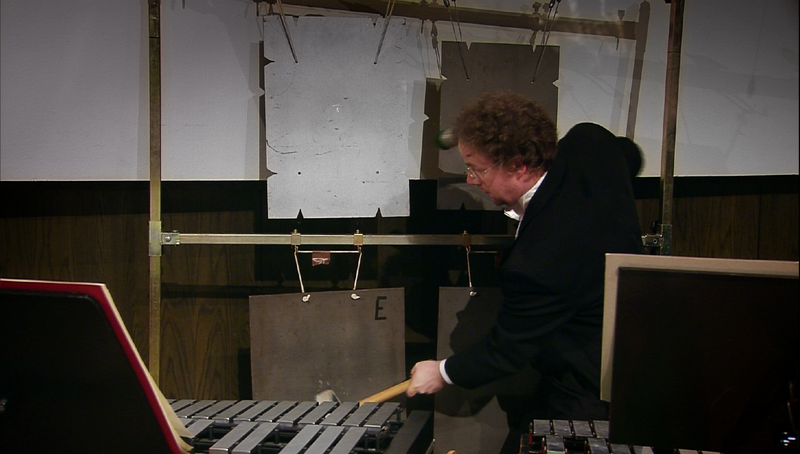Mahler Symphony No. 7 concert. Riccardo Chailly conducts the Gewandhaus Orchestra Leipzig. Directed for TV by Ute Feudel; audio production by Sebastian Braun; produced by Günter Atteln and Paul Smaczny. Released 2013, disc has 5.1 dts-HD Master Audio sound. Grade: C
This title is one of a series of all the Mahler symphonies performed by the Gewandhaus Orchestra under Chailly. All the titles in this series seem to suffer from poor video content. In this review we will first view some screenshots and later discuss video-content data.
First below is a typical whole-orchestra shot from this film. It just barely qualifies as whole-orchestra with quite a few players missing on the flanks. Also, the angle is too low to really get a good feel for the organization of the orchestra:
Feudel does provide some well thought-out shots. Next below we have a good view of most of the double basses:
Here we see 3 oboes with a flute and an English horn also in the frame:
Below is a nice view of second violins:
Next below we see trumpets and trombones:
The next 3 views below are more problematical. First we see a shot that is too shallow in angle to be worth much as a group shot. Instead it acts as a poorly-framed, small-scale shot of 2 horns:
This next shot below of cellos is too low --- the players in the back are largely obscured:
Below is another shot marred by poor framing. Half the screen is filled with out-of-focus instruments:
Now for a few shots of individual musicians. The shot of the horn player next below is a bit mysterious. Mahler often calls for the horns to be raised. Is this the best way to get the bell up into the correct position? Or is the player muting the horn? Or is the hand in the bell needed to achieve perfect intonation?
Mahler also loves to keep the percussionists on their toes:
Below we see a mandolin, not an instrument usually associated with symphonic works. But the mandolin can be clearly heard when played:
There is the usual overabundance of conductor and conductor-over-back shots. Below we see Chailly as he finishes the symphony:
And here he have an example of the low-value, conductor-over-backs shot:
Like the rest of the titles in this series, the picture and sound quality are both well done, and the performance itself is fine.
We determined that the video pace is fairly uniform throughout the entire title. So we ran the numbers (using a Wonk Worksheet) on Movement IV (Rondo --- Finale) as a representative sample of the film. In 17 minutes and 13 seconds of music in Movement IV, there are 267 clips. This results in an extremely fast pace of 3.9 clips per second. 73 conductor shots make up 27 percent of the movement's clips. 59 supershots (which are large-scale, part-orchestra, and whole-orchestra shots) make up 22 percent of the movement's clips.
, but we keep the grade at C out of respect for the good SQ, PQ, and performance.HDVDarts.com has established the following rules-of-thumb to identify a Blu-ray with DVDitis:
“A good symphony HDVD should have a slow pace with more than 10 seconds per video clip on average. 20 to 40% of the clips should be large-scale "supershots." Conductor shots should be less (way less really) than 20% of the clips in the video.”
Subject title badly flunks the pace test and the conductor test while barely passing the supershot test. So we diagnose DVDitis. (If you are not familiar with the term "DVDitis", please check out our special article on how to make a good video in Blu-ray of a symphony performance.)
Whereas Symphony No. 6 in this series (also done by video director Ute Feudel) has a goodly number of pretty part-orchestra shots, this Symphony No. 7 does not. There are also too many framing issues that mar what would be otherwise worthwhile shots.
Time for a grade. We reduce the grade from A+ to C+ for failing the pace and conductor tests. We could reduce the grade further to C for the framing issues noted.
OR














